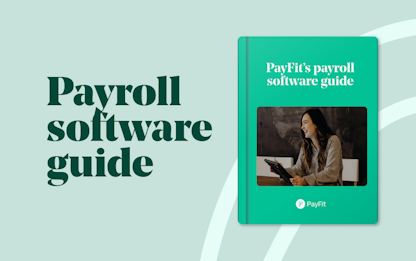- Blog
- |Managing Payroll
- >Finance
- >4 finance best practices
GUEST BLOG: 4 finance best practices for modern companies in 2021


After a year of upheaval and confusion, companies are looking for smart ways to control their finances in 2021. Cash management is once again a crucial focus for finance teams, while CFOs also want ways to save time and streamline processes.�
The ongoing crisis is just the push many businesses need to make lasting change. Now’s the time to modernise and improve work habits, before the focus shifts back to growing bigger and faster.
We still don’t know what’s in store for us in the coming months, so here are four best practices to ensure you’re ready for whatever comes your way.
1. Abandon paperwork
The number one time-waster for finance teams is still manual, repeated processes. You almost certainly waste time on data entry, physical filing systems, and fixing errors along the way. Not to mention the time it costs your other teams to fill out forms by hand.
We’ll look at the benefits of automation next, but modern finance teams need to start thinking digital-first, and using paper as a last resort. This shift requires a combination of good technology and progressive thinking.
A few steps in particular:
Digitise necessary documents. Invoices, payslips, and expense receipts can all be digital today. No need to print and store them in the filing cabinet.
Create internal records digitally. Likewise, purchase orders, expense claims, and even project plans should be digital. Wall calendars and whiteboards are nice, but they’re a problem the moment you have remote team members.
Use cloud tools. Software should be accessible from anywhere. Can your teams pick up a process from home if necessary? If it’s on paper, the answer is no.
But what does that look like in practice? Here’s how PayFit has updated payroll - a process that’s been around essentially forever.
PayFit
Payroll has traditionally been an extremely manual process for employers.
With an endless amount of paperwork required, back and forth discussions with accountants or payroll bureaus, the monthly payroll run has typically been an arduous and tedious process that can often hide the true value of payroll processes and payroll data.
However, solutions like PayFit allow employers to take control and manage payroll at source with dedicated support for the more complex aspects of payroll.
Thanks to PayFit’s innovative software, employee payslips are manually updated in real-time with all calculations automated.
Furthermore, all payslips are stored within an employee’s individual portal where they can choose to access and download them at their leisure.
2. Embrace automation
Moving away from paper doesn’t just save on stationary. Once documents are digitised by default, you can automate huge chunks of your most painful work.
And automation is more than just a timesaver. We humans tend to believe that experience and repetition make us more precise and less prone to error. This might be true in some pursuits, but data entry is always a minefield for mistakes. No matter how attentive you think you’re being, errors will slip through.
Automation tools are built to do these exact same tasks over and over again, exactly the same every time. Which saves your team's time for the more important work. A few ideas:
Use Zapier and smart Excel formulas to send data from place to place. The goal: zero manual data entry.
Integrate key tools with one another, and seek out tools specifically for their ability to integrate.
Instead of sending individual reminders about deadlines or missing documents, choose software that identifies these needs and sends them for you.
Let’s have another look at an example in the wild.
Spendesk
Closing the books is normally a slow and tedious process. But finance teams can save hours or even days simply by having expense automation do the repetitive work.
Spendesk gives you debit cards with the tracking built in. A purchase is made, the team member attaches their receipt, and the finance team has all the details they need.
At reconciliation time, you don’t need to confirm that a recorded payment did indeed take place. You already have the proof. Plus Spendesk works with tools like Xero and Netsuite, so you can close the books in a single click.
3. Empower other teams to take action
Some finance processes will always be primarily handled by finance teams from start to finish. But there are plenty which can be shared across the workforce, taking pressure off you.
Your team shouldn’t have to personally approve every credit card transaction, sign every contract, and balance every budget.
A few quick ideas:
Have managers prepare supplier contracts, so finance/legal only needs to do a quick review.
Make employees responsible for collecting invoices and receipts on time, and provide incentives for doing so.
Give training and tools to let teams handle their own budgets, so the CFO and planning teams can worry about the bigger picture.
Let’s stick with the legal theme for this example.
DocuSign
Supplier contracts can be tricky, which is why special legal expertise comes in handy. Whether that’s a lawyer, an experienced office manager, or the CFO, it’s always someone whose time is too important to waste.
DocuSign lets those people set the parameters, but any team member can ensure that the contract gets signed. Your lawyer indicates the information they need and places to sign, and then other employees can deal with the back-and-forth with the vendor.
Don’t underestimate how quickly those email chains and “quick chats” with team members add up. Instead, DocuSign notifies everybody involved (including the supplier) of what’s required, so you don’t have to outline every single step.
It’s still legally valid, and is digital-first too!
4. Focus on partnering with your business teams
Finance shouldn’t just be the bad cop. You have valuable skills and experience that should help the company grow - provided you get to use them.
So this year, make it a priority to get closer to your marketing, sales, and support teams. Help them develop knowledge in business planning and budgeting, so you’re not only on their radar when problems arise.
A few key ways to do this:
Help them build models to measure average customer value, and identify those clients likely to churn.
Teach other teams about key risk issues for the company, so they can identify problems themselves.
Bring data to discussions around pricing and packaging, and show the highest-value targets for your marketing and sales teams.
Here’s a great example: digital advertising is as popular and necessary as ever. But marketers aren’t always natural-born budgeters. Your FP&A teams can help them build smart frameworks to measure ROI and slowly ramp up spending, safe in the knowledge that they’re doing the right thing.
And because digital advertising tools are so reactive, you can control company spending in real-time. If bid prices go down in certain markets, you can reallocate budgets there. You can also freeze budgets in a moment when spending gets too high.
This only works if you have a close relationship with your business teams, and they aren’t trying to hide their work from you.
Expect the unexpected
Forgive the cliché(s), but the one thing we know about 2021 is we don’t know what we don’t know. By summer, business could be more or less back to “normal". Offices may be open again and we may just try to forget this whole crisis ever happened.
Or perhaps we’ll be exactly where we are today, patiently waiting for things to change.
Patience is good, but you don’t have to wait to make improvements in your finance processes. Now’s a good time to change some of the more old fashioned, clunky aspects of your day-to-day.
The four suggestions above are a great place to start.
This article was written by Erleta Lenjani, Spendesk's Strategic Partnerships Manager. In her role, she helps business consultancies and accounting firms provide tailored expense management services for their clients.


Types Of Flexible Working - A Guide For Employers

What is Flexible Working Within the UK Workplace?

Understanding the Paternity Leave Changes in 2024

International Day of Transgender Visibility Guide

A Guide to 360 Degree Feedback for UK HR Teams

